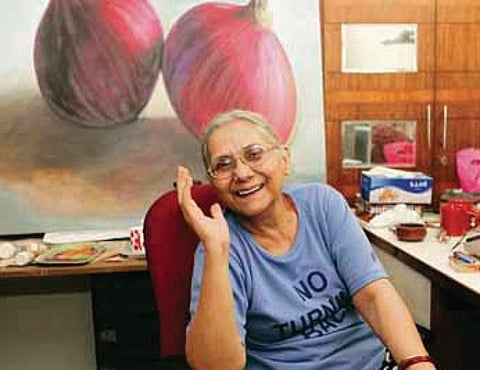Tribute to a ‘trouble-maker’
There is no nude figure. There is the ‘unclothed body’,” says Kishore Singh, SVP, DAG during a walkthrough of ‘Gogi Saroj Pal: Mythic Femininities’, the second retrospective of India’s pioneering feminist painter. Clothes are indicators of class, region, age and other factors and they or nudity, did not matter to Gogi, he adds. “The ‘nudity’ or ‘clothes’ are not the subject. The ‘woman’, her story and the underlying philosophy of empowerment is,” Singh tells TMS.
The ongoing show, a tribute to the painter, who died this January, features paintings and life-size sculptures of bare feminine figures, even contortions of the female body, monks, animal figures and hybrid creatures. Each frame is charged with the undercurrents of anti-patriarchy and the pro-empowerment stance of the National Award-winning artist. “Her art is about the complexities of womanhood, examining how pride, shame, power, authority, agency, clothing, hair and the physical body shape reflect female identity. She challenged the conventional norms of gender representation long before it became a common practice,” says DAG CEO and MD Ashish Anand.
Equality, inequalities
Gogi was born in 1945 in Neoli, Uttar Pradesh, to a Himachali family with origins in Lahore. Her father, a freedom fighter, was incarcerated in a British India jail and tortured. Singh, a long-time friend of Gogi, feels that perhaps “this family history of strength” was imbibed by her and turned her into a feisty rebel. However, her greatest inspiration was her grandmother, Prem Devi. “She had a profound influence on the artist and always told her to stand up for her rights,” Singh says, adding: “Gogi calls herself a ‘troublemaker’ because she refused to be bullied by boys in school. She did not take any nonsense from anyone regardless of age or gender.”
Gogi spent a lot of time in Kangra, where Prem Devi was a school principal, during her formative years. She witnessed the migration of Tibetan refugees, especially monks, to Dharamshala in the late 1950s. Hence, the imagery of monks made its way into her works — for instance in the ‘Young Monks’ series and the ‘Human Landscape’. But the central theme of her paintings was always an exploration of inequality in relationships. Singh says that when in Kangra, she observed how children were sent to monasteries by parents to express their Buddhist faith. “However, nobody asks the child’s opinion on the matter. Gogi’s concerns are therefore very humanitarian while being a feminist,” he says.
In the ’60s, Gogi went to pursue a bachelors in painting at Banasthali Vidyapith in Rajasthan and then a diploma in painting in Lucknow. By the end of the ’60s, she was in Delhi and developed a style not inspired by any other prominent artist but one that is “distinctively born out of her own life experiences and the inequalities she had seen in her life,” Singh says.
Leaving a mark
Her grandmother had once faced harassment from men on the streets of Anarkali Bazaar in Lahore for removing the chaddar over her sari on a hot day, which eventually inspired her grandmother to stop wearing chaddar altogether. This act of rebellion left a lasting impression on Gogi. She went on to paint series like ‘Being A Woman’, ‘Mandi’ and ‘Halley’s Comet’, all of which are strong critiques of patriarchal society. For instance, ‘Mandi’ targets the male gaze with a clan of women semi-clad in vibrant silhouettes returning the gaze piercingly as if countering the gaze of viewers. In ‘Halley’s Comet’, the paintings are a commentary on superstition. The comet, which re-appears every 75 years, is said to cause ill-health in pregnant women, particularly those carrying male children. “The superstition about the comet subjugated a woman because she will follow everything in that period for the betterment of her child and to save her baby. So, when people chose the most vulnerable moment in a woman’s life to dictate to her, Gogi questioned such regressive myths,” Singh says.
Gogi also paints portraits of empowerment. Her ‘Nayika’ and ‘Hathyogini-Kali’ series show women in monochromes, with expressive eyes and self-assured postures. “Gogi’s Nayikas express a woman’s desire. Her woman is self-absorbed, she is not waiting for anybody to please her; she pleases herself. They are not looking at the viewer, but admiring themselves,” Singh says.
A humanitarian
Singh recalls Gogi’s placing the agency of animals on the same level as humans. According to Hindu mythology, the Kamdhenu is a wish-fulfilling cow that feeds all. Gogi portrays her as a hybrid creature with the torso of a female and the trunk of a cow. She draws a parallel between women and cows to emphasise how both are seen in the role of the ‘nurturer’, irrespective of their choice. “A role has been assigned to both of them. Nobody asks what they need,” Singh points out.
Similarly, in another hybrid series, ‘Dancing Horse’, Gogi shows the torso of a female with hands adorned with alta (dye) with the trunk of a horse. “Horses are trained to dance at weddings in north India. Gogi despised this idea of taming animals to please us,” he adds. Her work was about giving power and choice to the most “othered” beings in society. “The cow, the horse, the kids at Kangra’s monasteries, the bird-like creature Kinnari, women, have this in common — somebody else is making decisions for them. Gogi tries to bring our attention to that and change the discourse with her stimulating works,” he says.
The exhibition is on display till May 25 at DAG, 22A Janpath from 10.30am to 7pm

